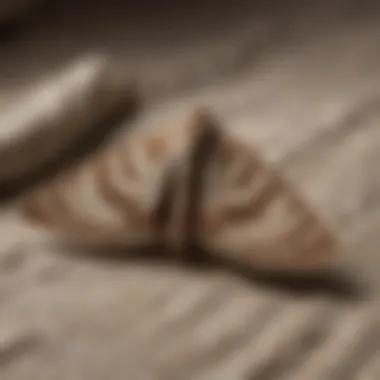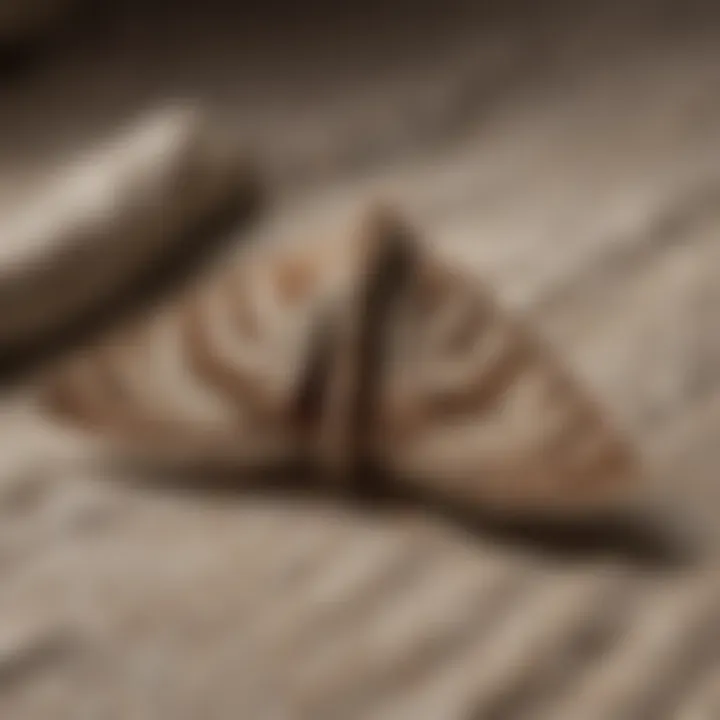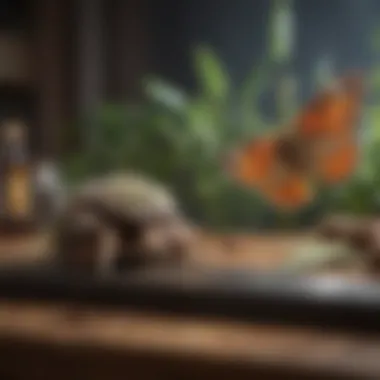Effective Strategies for Eliminating Moths in Your Home


Intro
Moths can be a silent yet destructive presence in homes. They often invade closets, pantry, and other storage areas, damaging valuable textiles and food sources. Understanding how to effectively eliminate moths is essential for maintaining a harmonious living environment. This article offers a thorough exploration of strategies not only to identify moth presence but also to prevent future infestations.
By delving into both immediate and long-term techniques, homeowners can take charge of their living spaces. The following sections will outline various aspects of moth elimination, emphasizing relevant insights and practical measures.
Detection of Moths
Recognizing the signs of a moth infestation is the first crucial step in addressing the problem. It is important to look for the following indicators:
- Visible moths: Adult moths often flutter, while larvae are generally more difficult to spot.
- Damage to textiles: Look for holes or frayed edges in clothing, blankets, and carpets.
- Presence of larvae: Moth larvae can usually be found in dark corners, undisturbed areas, or near damaged materials.
If these signs are present, action is needed to mitigate the risk of further damage.
Preventive Measures
Prevention is often easier than dealing with an active infestation. Here are several preventive measures:
- Regular cleaning: Vacuum regularly to remove potential eggs and larvae. Focus on places like closets, attics, and under furniture.
- Proper storage: Store clothing and textiles in airtight containers to discourage moth entry. Consider using cedar chips or mothballs for added protection.
- Food safeguards: Keep pantry items sealed. Inspect for any signs of moth larvae in dry goods.
By incorporating these steps, homeowners can significantly lower the likelihood of moths taking residence in their homes.
Removal Strategies
Once moths are detected, it is time to implement effective removal strategies. Here are approaches that can be employed:
- Chemical treatments: Sprays and powders designed for moth removal can be focused on affected areas. Ensure to follow instructions carefully and ventilate the space well after use.
- Natural remedies: Essential oils like lavender, eucalyptus, and peppermint can act as deterrents. Spraying diluted solutions or placing soaked cotton balls in moth-prone areas may help.
- Professional services: If infestations become overwhelming, consulting with pest control professionals may provide a more extensive solution.
The End
Eliminating moths involves a structured approach that incorporates detection, prevention, and removal. By remaining vigilant and proactive, homeowners can protect their living spaces from potential damage. The strategies outlined can assist in maintaining a moth-free environment, safeguarding valuable textiles and contributing to a more pleasant living experience.
"An educated approach towards pest management can ultimately save homeowners time and money while preserving their belongings."
This guide serves as a resource for anyone facing moth-related challenges and looking for comprehensive solutions.
Understanding Moth Behavior
Understanding moth behavior is essential for effective pest management. Different species of moths exhibit varied habits, which influence their impact on households. Familiarity with these behaviors guides homeowners in identifying infestations early and implementing appropriate strategies. Recognizing the types of moths present can dictate the most effective eradication approach. This knowledge benefits the homeowner by ensuring that efforts are not misdirected, minimizing damage to textiles and food sources, and ultimately preserving a harmonious living environment.
Different Types of Moths
Clothes Moths
Clothes moths are notorious for their destructive feeding habits. They are particularly drawn to natural fibers, causing significant damage to clothing, upholstery, and other textiles. A key characteristic of clothes moths is their larvae, which are the actual culprits behind the damage. By understanding the behavior of clothes moths, homeowners can make informed decisions about cleaning and storage practices. This type of moth is particularly relevant as it can quickly escalate into a wider infestation, making early detection vital.
Pantry Moths
Pantry moths, also known as Indian meal moths, are commonly found in stored food items. They primarily infest grains and dried food products, leading to spoilage and contamination. The main characteristic of pantry moths is their ability to lay eggs in food storage areas. This aspect is crucial for homeowners to understand because it emphasizes the need for proper food storage techniques. By addressing pantry moths, individuals can protect their food supply and prevent further economic loss.
Webbing Moths
Webbing moths are recognized by the silky webbing they leave behind in infested areas. These moths are known to feed on fabrics and stored items, creating unsightly webs. Their presence can indicate a more extensive moth issue, which requires immediate attention. The distinctive feature of webbing moths is their silk production, which makes their nests easy to identify. This unique characteristic allows homeowners to target affected areas more effectively, mitigating damage to valuables.
Lifecycle of Moths
Eggs
Moth eggs are small and often laid in hidden areas, making them hard to detect. Understanding the egg stage is vital in prevention efforts, as intervening at this stage can significantly reduce future populations. Eggs can hatch within a week, depending on environmental conditions. By learning about the egg stage, homeowners can appreciate the rapid reproductive potential of these pests.
Lava Stage
The lava stage, more accurately called the larval stage, is when moths are most destructive. Larvae feed voraciously on fabrics or food sources, causing visible damage. Recognizing this stage gives homeowners a chance to act promptly. Effective treatments during this phase can prevent further infestation.
Pupation
Pupation is a preparatory stage before moths emerge as adults. During this period, larvae cease feeding, and homeowners might mistakenly believe that the infestation is over. Understanding this stage is significant because it can last several weeks, during which the potential for future infestations exists. Monitoring storage areas for pupae can inform early intervention strategies.
Factors Attracting Moths


Food Sources
Food sources play a critical role in moth attraction. They seek grains, seeds, and dried fruits found in pantries. Shortcomings in food storage invite these pests. This knowledge is crucial for formulating strategies to reduce vulnerabilities in food preservation. Effective control of food sources can drastically decrease the chance of infestation.
Environmental Conditions
Environmental factors, such as humidity and temperature, significantly influence moth behavior. Moths prefer dark, warm, and humid areas. Maintaining low humidity levels can deter moths from taking up residence. Knowing these conditions assists homeowners in proactive pest management approaches, helping to maintain hostile environments for them.
Storage Practices
Improper storage practices attract moths into homes. Storing clothing without adequate protection or failing to seal food items can create an inviting habitat. This understanding can lead to improved storage habits that deter infestations. Maintaining cleanliness and utilizing proper storage solutions ensures a minimal risk of moth activity.
Signs of Moth Infestation
Identifying the signs of moth infestation is crucial in managing these pests effectively. Moths often cause significant damage to garments and foods, and recognizing the early indications of their presence can prevent further losses. This section elaborates on the visual indicators, unusual odors, and increased sightings that suggest moth activity in your home. Each of these signs serves as a warning, enabling homeowners to take prompt action against potential infestations.
Visual Indicators
Visual indicators are often the first signs that homeowners notice. Detecting these cues enables timely intervention to halt the spread of moths within the living space.
Damage to Clothing
Damage to clothing often manifests as small holes or fraying in fabrics. This damage can be particularly distressing, as it affects valuable and cherished garments. Moths are primarily drawn to natural fibers such as wool, silk, and cotton. The key characteristic of this kind of damage is that it usually appears in areas that are less visible, such as underarms, seams, or hemlines. This subtlety makes it easy to overlook until significant damage has occurred. Prioritizing inspections of these areas is beneficial for early detection. The unique feature of this damage is that it's not just a cosmetic issue; it can lead to the complete ruin of items if left unchecked. In this article, knowing how to spot damage can empower readers to take immediate corrective action before losing their valued textiles.
Presence of Larvae
The presence of larvae is another alarming sign that moths are infesting your home. Usually, they are small, caterpillar-like creatures that can be found near damaged fabrics or food sources. Recognizing larvae is vital, as it indicates that adult moths are laying eggs, which can rapidly increase their population. A key characteristic of these larvae is their tendency to stay hidden among fabrics or in dark corners, which can make spotting them challenging. Detecting larvae early allows for quicker remediation methods. It is also worth noting that the unique feature of the larvae stage is that they feed voraciously on fibers, accelerating damage. Spotting them is crucial in initiating effective pest control measures.
Cocoons in Storage Areas
Cocoons often appear in storage areas, frequently unnoticed for extended periods. These silk-like structures are the pupal stage of moths, and their presence indicates that moths are likely residing in your home. The key characteristic of cocoons is that they can vary in color, typically resembling small, light-colored masses. This variability means they may blend in with their surroundings, making them easy to miss. Identifying cocoons can prevent further infestation and offers an opportunity to address the source of the problem directly. The unique feature of cocoons is the number of moths they represent; finding one may mean many others are nearby. Understanding the context of cocoons is essential for determining the urgency of remedial actions.
Unusual Odors
Unusual odors may not be the most apparent sign of moth infestations but can serve as an essential clue. Moths and their larvae can produce scents that are often described as musty or reminiscent of stale food. Identifying these odors can help pinpoint affected areas, particularly in closed storage spaces. If a person notices such smells in conjunction with other indicators, it warrants further investigation. Failing to address these odors may lead to larger infestations.
Increased Sightings
Increased sightings of moths themselves, particularly during the evening, indicate potential issues. Adult moths are attracted to light and may be seen fluttering around light fixtures or windows. Noticing a higher frequency of these sightings can be a critical sign of an established infestation. Failing to react to increased sightings can exacerbate the problem, leading to more damage over time. Homeowners should record occurrences and take action to eliminate the attractants or set traps.
In summary, recognizing the signs of moth infestation is essential for effective moth management. Early detection of visual indicators, understanding unusual odors, and monitoring increased sightings can help homeowners take decisive action before facing extensive damage.
Immediate Measures to Combat Moths
Addressing moth infestations promptly is crucial for effective pest management in a home. Taking immediate measures targets the problem before it escalates and can minimize damage to valuable textiles and food sources. Homeowners can implement several strategies that are both practical and efficient. These initial actions set the groundwork for longer-term solutions while reducing the current moth population.
Vacuuming and Cleaning
Regular vacuuming is one of the most straightforward methods to combat moths. By frequently cleaning carpets, upholstery, and hard-to-reach corners, you can physically remove moths, larvae, and eggs. Pay special attention to areas where dust and debris accumulate, as these spots can provide a conducive environment for moth reproduction.
In addition to vacuuming, wash textiles thoroughly. Clothes and linens stored for long periods should be laundered before putting them back. Consider using hot water, as it effectively kills moth eggs and larvae. Cleaning storage spaces helps eliminate these pests thoroughly.
Heat Treatment
Using a Clothes Dryer
The use of a clothes dryer is an effective and practical solution to eliminate moth infestations. It is advised to place infested items in the dryer on a high heat setting for at least 30 minutes. This method works because the high temperature is lethal to both moth larvae and eggs. The key characteristic of using a clothes dryer is its accessibility; most homeowners have one in their residence. This makes it an immediate option when dealing with a moth issue.
A unique feature of this approach is that it is not only effective but also convenient. However, items that cannot withstand high heat should not be subjected to this treatment, which serves as a limitation.
Professional Heat Treatments
Professional heat treatments are another option for dealing with moth infestations. Exterminators can raise the temperature of an entire room or area to levels that are lethal to moths, larvae, and eggs. One notable benefit here is the ability to treat multiple items and surrounding areas at once, ensuring comprehensive eradication. This method is beneficial for larger infestations or hard-to-reach spaces where vacuuming or laundering may not suffice.
However, professional treatments can be costly and may not always be necessary for minor infestations. The primary consideration here is assessing whether the investment is justified based on the extent of the issue.
Chemical Insecticides
Chemical insecticides can provide immediate relief when used correctly. These products are specifically formulated to target moths and can be effective in reducing their population quickly. When selecting an insecticide, look for those that specifically list moths on the label.
Some products require a direct application, while others can be sprayed in surrounding areas and storage spaces. It is essential to follow safety instructions when using chemical treatments to protect both the family and pets.


Long-term Prevention Strategies
Long-term prevention strategies are crucial in ensuring that moths do not become a recurring problem in the home. These strategies focus on practical measures that homeowners can adopt to create an environment where moths find it difficult to thrive. The importance of these strategies cannot be overstated. They not only protect textiles and food items but also reduce the stress associated with dealing with infestations.
Proper Storage Techniques
Use of Airtight Containers
Using airtight containers is a key strategy in long-term moth prevention. These containers are specifically designed to prevent both air and moisture from entering, which helps in preserving food and preventing pests from accessing it. They are particularly effective for food items, as they keep moths away from grains, cereals, and other perishables. The airtight seal acts as a barrier, making it difficult for moths to lay eggs or enter the containers.
One of the unique features of airtight containers is the variety of materials they can be made from, such as glass, plastic, or metal. Each material has its own set of benefits. For example, glass containers are non-toxic, easy to clean, and can also be visually appealing. Contrastingly, plastic containers are lightweight and durable. The advantage of using these containers is clear: they provide a secure method of storage that significantly reduces the risk of moth infestations.
Maintaining Cleanliness
Maintaining cleanliness in storage areas is another fundamental aspect of long-term prevention. This involves regular cleaning and organizing of spaces where food, textiles, and other items are stored. A clean area is less attractive to moths, which are often drawn by crumbs, spills, and detritus. The key characteristic of cleanliness is its simplicity, yet it can yield substantial benefits in pest management.
One unique aspect of maintaining cleanliness is the necessity for regular inspections and tidying up. Not only does this deter moth activity, but it also allows homeowners to identify potential risks before they escalate. The main advantage of cleanliness in moth prevention is that it fosters an environment that is much less hospitable to these pests, thus reducing the likelihood of an outbreak.
Natural Repellents
Natural repellents can also serve as effective long-term prevention strategies against moths. Their ability to deter moths without harmful chemicals makes them an appealing option for many homeowners.
Lavender
Lavender is well-known for its pleasant scent, but it is also an excellent natural moth repellent. The strong aroma of lavender is unsettling to moths and can effectively keep them at bay. Many homeowners choose lavender for its dual role; it freshens the space while providing pest control.
A unique feature of lavender is its versatility. It can be used in dried sachets, essential oils, or even as a planted flower around important areas. The moth-repelling qualities of lavender are a major advantage, though it is vital to remember that its effectiveness may decrease over time, necessitating occasional replacements.
Cedar
Cedar wood is another natural repellent commonly used in the fight against moths. The natural oils in cedar create an environment that moths find unpleasant. This method is not only effective but also adds a pleasant aroma to storage areas. Cedar blocks or chips can be placed in closets and drawers for added protection.
The unique feature of cedar lies in its longevity; it can last for several months before losing its potency. Regularly sanding the wood can refresh its scent and effectiveness. This eco-friendly approach is advantageous because it minimizes exposure to synthetic chemicals, appealing to those who prefer natural solutions.
Essential Oils
Essential oils from various plants also serve as effective repellents. Oils like peppermint, eucalyptus, and tea tree have properties that deter moths. A few drops of these oils on cotton balls can be a practical deterrent in closets and storage areas.
The unique feature of using essential oils is their diverse range of options. Homeowners can choose specific scents that appeal to them while still being beneficial for pest management. However, a disadvantage may include the need for frequent reapplication to maintain their effectiveness. Yet, the natural aspect makes them a favored choice for many.
Regular Monitoring
Regular monitoring for the presence of moths will help catch infestations before they escalate into larger problems.
Using Traps
Using traps is an effective way to monitor moth populations. Moth traps typically contain pheromones that attract male moths, leading to their capture. This is useful not only for reducing the population but also for learning about moth activity in the home. The key characteristic of traps is that they provide immediate feedback on whether preventive measures are working.
A unique feature of moth traps is their simplicity of use. They do not require special skills or equipment and can easily be placed in various locations to monitor for issues. Although traps will not eliminate an existing infestation completely, their monitoring capability is invaluable for managing moth populations, which justifies their use.
Scheduled Inspections
Conducting scheduled inspections can significantly enhance long-term prevention efforts. This involves systematically checking areas where moths are likely to thrive. Regular assessments allow homeowners to discover any signs of moth activity early. The key characteristic of scheduled inspections is their proactive nature, which enables timely action when necessary.
One unique aspect of this practice is the establishment of a routine, linking inspections with regular cleaning or other household chores. This integration helps in maintaining diligence while also addressing other home care tasks. The major advantage is that it keeps pest management at the forefront of a homeowner's mind, reducing the chance of significant infestations.
Moth-Proofing Your Home
Moth-proofing your home is a crucial aspect of maintaining a moth-free environment. This involves implementing a series of preventative measures to limit the chances of moths entering and thriving in your space. By taking simple yet effective actions, one can significantly reduce the likelihood of infestations, preserving valuable textiles and ensuring a more comfortable living atmosphere. The benefits extend beyond just preventing moths; these practices often lead to a general improvement in home cleanliness and organization, which contributes positively to household morale.
Maintaining Optimal Humidity Levels
Humidity control is a vital consideration in moth-proofing. Moths prefer humid environments as they facilitate breeding and survival. Keeping humidity levels in check can be achieved by using dehumidifiers in damp areas of the home, such as basements or laundry rooms. Aim for indoor humidity levels between 30-50%. These ranges not only make conditions inhospitable for moths but also improve overall indoor air quality. Regularly monitoring humidity through hygrometers can assist in maintaining these levels.
Sealing Entry Points
Cracks and Gaps
Cracks and gaps in walls, floors, and around windows can become pathways for moths. These small openings may seem insignificant but contribute greatly to a moth infestation. Sealing them effectively restricts moth movements and prevents them from nesting in your home. Caulking is a common and efficient choice for resealing these areas. It's an easy task that requires minimal tools and materials, making it particularly advantageous for homeowners who seek affordable maintenance solutions. Ignoring these gaps typically leads to larger problems, potentially leading to costly extermination.
Window Screens


Window screens serve as an effective barrier against many pests, including moths. Properly fitted and regularly maintained screens can significantly reduce the likelihood of moths flying in. Not only do screens provide ventilation while deterring insects, but they also enhance the energy efficiency of your home by allowing fresh air to circulate without creating openings for unwanted guests. Investing in good-quality, tightly woven screens can ensure that even the smallest moths cannot enter. It is essential to inspect screens regularly for wear and replace any that are damaged.
Seasonal Cleaning Habits
Maintaining cleanliness is fundamental to moth-proofing. Regular cleaning routines help eliminate moth eggs and larvae that may be lurking in textiles or hidden corners. This includes vacuuming carpets, upholstery, and closets to remove potential food sources and clutter. Seasonal cleaning is a strategy that allows homeowners to delve deeper into areas that often get neglected. For example, guideline tasks during spring cleaning can include washing drapes, cleaning behind large furniture, and inspecting storage areas for any signs of moth activity. This proactive approach can greatly diminish chances of an infestation, ensuring a more pleasant living environment.
Seeking Professional Help
When dealing with a moth infestation in your home, seeking professional help can be a wise decision. Homeowners often attempt to tackle the issue themselves, using store-bought products or home remedies, but the effectiveness can vary greatly. Moths can reproduce quickly, leading to a larger infestation if not handled promptly and properly. Professionals have more experience and access to more potent solutions, often tailored to the specific type of moth involved.
Benefits of Consulting an Exterminator
- Expert Assessment: Exterminators can accurately identify the species of moths, which is critical for an effective treatment plan.
- Tailored Treatment Plans: They can create customized solutions based on your home's specific conditions and infestation severity.
- Long-term Solutions: Professionals may suggest long-term preventative measures to avoid future infestations.
In addition, professional pest control often includes follow-up visits to ensure that the treatments are effective, something that is hard to manage with DIY solutions. Oftentimes, the process can involve a combination of treatments, which professionals can handle more effectively.
When to Consult an Exterminator
It’s important to recognize the right moments when professional intervention is necessary. If you notice multiple signs of infestation, such as widespread damage to clothing, a noticeable presence of larvae, or cocoons found in storage areas, it may be time to consult an exterminator.
Additional scenarios where professional help is advisable include:
- Persistent Problems: If previous attempts at extermination have failed, consulting a professional may provide the expertise necessary for success.
- Widespread Infestation: For large infestations, determining the extent of the problem may be challenging and typically requires professional tools and expertise.
- Sensitive Environment: Homes with children or pets might benefit from the knowledge of professionals who can select safer treatment options.
Recognizing the signs early, and acting with appropriate urgency can prevent further damage and restore peace of mind.
Questions to Ask Pest Control Services
When selecting a pest control service, asking the right questions can help ensure that you choose a qualified and effective exterminator. Important inquiries include:
- What methods do you use for moth removal? This helps you understand their approach and whether it aligns with your values regarding chemical exposure and safety.
- Can you provide references or reviews from previous clients? This can give insight into their track record and reliability.
- What kind of warranty or guarantee do you offer? A reputable company should stand behind their work, offering a guarantee that the infestation will be controlled or managed after treatment.
- How often do you recommend follow-up treatments? Understanding their maintenance schedule can help you maintain a moth-free environment effectively.
By carefully evaluating pest control services, you increase the chance of successfully eliminating moths and protecting your home effectively.
Monitoring Effectiveness
Monitoring effectiveness is a crucial part of managing moth infestations within your home. Understanding how well your strategies are working can prevent re-infestation and protect your valuables. By closely observing the outcomes of treatment methods, you ensure that your home remains a safe space free from these pests. This section will cover key elements of evaluating treatment results and the adjustments necessary to increase effectiveness.
Assessing the Results of Treatments
To effectively manage an infestation, it is essential to assess the results of all treatment methods you have applied. Start by observing the areas where you suspect moth activity. Check for signs of new damage to textiles or pantry items. Furthermore, you should look for visible larvae and the presence of adult moths. Conduct regular inspections at frequent intervals to determine the level of persistence of the infestation.
Additionally, maintaining a log of your observations can be helpful. Record when and where you applied treatments and any visible changes after these applications. If you notice a decrease in moth activity following these methods, it suggests that you are on the right track. However, if issues persist, you may need to reconsider your approach.
Adjusting Strategies Based on Findings
Once you have collected data on the effectiveness of your strategies, adjusting your approach may be necessary. Each home is unique, and factors such as humidity levels and types of materials present can affect the outcome of your treatments. If your initial methods do not yield the desired results, consider trying alternative approaches.
For instance, if vacuuming and cleaning have not lessened the infestation, you might want to explore professional heat treatments or stronger insecticides. Moreover, integrating natural methods, like essential oils or increased cleanliness, could supplement chemical solutions effectively.
Regularly reviewing your findings and adapting strategies ensures the best chance of eradication. Each decision should be informed by the data you collect.
"A comprehensive monitoring strategy can save you time and resources, ensuring that your home remains moth-free for the long term."
Adjusting your strategies based on findings not only increases your success rate but also fortifies your long-term plan against potential future infestations. Consistent reviews highlight areas for improvement and develop a robust approach to pest management.
Long-term Commitment to Pest Management
Long-term commitment to pest management is critical for keeping moths and other pests at bay. This goes beyond immediate fixes and treatments. It requires a thorough understanding and consistent application of various strategies. When managing moth populations, a sustainable approach is essential to ensure that these pests do not return. An established routine can save homeowners time, effort, and money while preserving textiles and food items.
A key benefit of committing to a long-term pest management strategy is the reduced likelihood of infestation recurrence. Moths are resilient creatures. While quick fixes can tackle an existing problem, the absence of a continual monitoring and prevention plan can allow new infestations to arise. Thus, homeowners can better protect their belongings by remaining vigilant and proactive.
Establishing a Routine
Establishing a routine is an integral part of long-term pest management. Homeowners should regularly check for signs of moth presence, which can include damaged textiles or the sighting of larvae. Scheduling inspections monthly can help identify potential problems early.
A cleaning routine is also vital. Frequent vacuuming, especially in areas known for moth activity, helps remove eggs and larvae. This is particularly important in closets and pantry areas.
Moreover, the introduction of preventive measures, such as natural repellents, should become a common practice. Products like lavender sachets or cedar blocks can deter moths from laying eggs in stored materials.
Community Awareness Programs
Engaging in community awareness programs is another effective strategy for long-term moth management. These programs can educate the public about the importance of pest control practices. By sharing knowledge, communities can work together to tackle the consequences of moth infestations effectively. Initiatives can include workshops, online forums, or local events that focus on pest management techniques.
A community effort not only raises awareness but also fosters shared resources. Connecting with neighbors allows for the exchange of traps or recommendations for pest management services.
Community engagement enables a holistic approach to pest management, making the environment less hospitable for moths and promoting overall hygiene.















